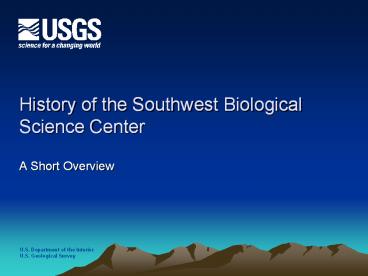History of the Southwest Biological Science Center - PowerPoint PPT Presentation
1 / 17
Title:
History of the Southwest Biological Science Center
Description:
Utilize systems ecology to evaluate responses of fauna and flora to natural and ... Ecology. Aquatic. Invertebrates. Cultural. Anthropology. Funding Agency Partners ... – PowerPoint PPT presentation
Number of Views:31
Avg rating:3.0/5.0
Title: History of the Southwest Biological Science Center
1
History of the Southwest BiologicalScience Center
- A Short Overview
2
History of SBSC
- Center formed on October 1, 2002.
- Four existing research stations transferred.
- Grand Canyon Monitoring and Research Center
- Colorado Plateau Research Station
- Canyonlands Research Station
- Sonoran Desert Research Station
3
Southwest Biological Science Center Locations
4
Grand Canyon Monitoring and Research Center
- The largest research station in SBSC.
- Originally a Bureau of Reclamation facility that
was formed in 1995 out of a preexisting BOR
program known as the Glen Canyon Environmental
Studies (GCES). - Transferred to USGS in 2000.
- Transferred to SBSC in 2002.
5
Colorado Plateau Research Station
- Originally a National Park Service unit formed in
1989 as a Cooperative Park Studies Unit. - Transferred to the National Biological Survey in
1994 and made a part of FORT (MESC). - Transferred to USGS in 1996 and made a partof
FRESC. - Transferred to SBSC in 2002.
6
Canyonlands Research Station
- Originally a National Park Service unit formedin
1987. - Transferred to the National Biological Survey in
1994 and made a part of FORT (MESC). - Transferred to USGS in 1996 and made a part of
FRESC. - Transferred to SBSC in 2002.
7
Sonoran Desert Research Station
- Originally a National Park Service unit formed in
1974 as a Cooperative Park Studies Unit. - Transferred to the National Biological Survey in
1994 and made a part of WERC. - Transferred to the USGS in 1996 and left as a
part of WERC. - Transferred to SBSC in 2002.
8
SBSC Mission Statement
- The U.S. Geological Surveys Southwest
Biological Science Center provides quality
science and facilitates the use of scientific
information in understanding processes and
managing resources - emphasizing species,
ecosystems, and landscapes of the Southwest.
9
SBSC Vision
- SBSC is recognized internationally as a premier
USGS Science Center that produces innovative
long-term programmatic research, and provides
relevant and meaningful answers to land
management questions throughout the Southwest.
SBSC research serves to meet the complex needs of
resource managers and society in the context of
rapid social and environmental change. The Center
is financially stable, has a diversified work
force that thinks and acts strategically, and
fosters a collaborative, fun, and rewarding
working environment
10
SBSC Vision, continued
- With its large-scale and cost-effective
research, SBSC bridges the science-management
interface in multiple disciplines. The Center
understands stakeholder interests, and is
recognized by its partners and clients as a
responsive research organization that is
objective, product-oriented, consistently
reliable, and a timely provider of scientific
information and technical support on resource
management issues.
11
The Goals of SBSC
- Utilize systems ecology to evaluate responses
of fauna and flora to natural and anthropogenic
influences - Develop and synthesize the biological knowledge
needed to sustain and restore ecosystems - Develop tools for assessing status and long-term
trends of animal and plant populations
12
The Goals of SBSC, continued
- Use integrated, long-term research to model
linkages among ecosystem components - Utilize information synthesis to provide a
scientific foundation for federal policies and
management strategies related to natural
resources in the arid southwest - Disseminate the latest in technical information
and research findings in a timely manner.
13
Research Emphases
- Herpetology
- Vegetation Mapping
- Large Mammals
- Inventory and Monitoring
- Paleoecology
- Sedimentology
- Soil Ecology
- Small Mammals
- Avian Ecology
- Desert FishesEcology
- AquaticInvertebrates
- CulturalAnthropology
14
Funding Agency Partners
- Bureau of Reclamation
- National Park Service
- Bureau of Land Management
- Corps of Engineers
- USGS (Western Region, Reston VA.)
- Fish and Wildlife Service
- Department of Defense
- Department of Energy
15
Research Partners
- National Park Service
- Bureau of Land Management
- Bureau of Reclamation
- Fish and Wildlife Service
- Arizona Game and Fish
16
Research Partners, continued
- U.S. Geological Survey
- Water Resources
- Geography
- Geology
- University of Arizona
- Northern Arizona University
17
Partnerships Funded by SBSC
Year Number of Cooperative Agreements Total Funds Awarded
FY03 61 3,589,180
FY04 53 3,528,009
Total 114 7,117,189































